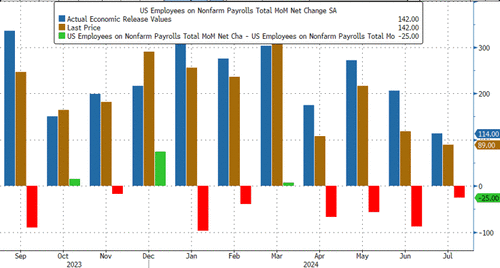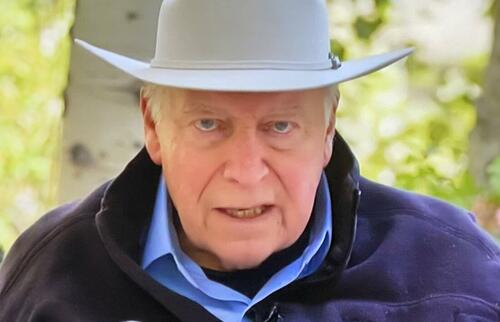Cheney Reaction
By Benjamin Picton, senior macro strategist at Rabobank
Cheney Reaction
Friday’s US payrolls report was supposed to settle the question of whether the Fed would be cutting by 25bps next week, or 50. On Thursday of last week the OIS futures had 33.8bps of cuts priced in for the September meeting. Today, it has 33.2bps of cuts priced in. Clearly the signal wasn’t as clear as many would have been hoping.
The reaction in market pricing might come as a surprise to many who took the time to read through the numbers. Employment growth in August of 142,000 exceeded the originally-reported 114,000 figure for July - which helped to precipitate a mini crash in markets – but was a long way shy of the 165,000 median estimate on the Bloomberg survey.
The two-month net payrolls revision also looked grim. If markets thought that 114,000 new jobs in July was a bad result when those figures were first released, the revised figure of just 89,000 jobs must surely be a worry. It’s worth keeping in mind that the June payrolls report was revised down from 206,000 to 118,000, and the May report was revised down from 272,000 to 216,000. Are you sensing a trend here?
The one bright spot in the report might have been the 1-tick decline in the unemployment rate from 4.3% to 4.2%. That was as-expected by surveyed economists, but while the headline unemployment rate was improving the U6 rate rose to 7.9%, the worst result since October of 2021.
The indecisive reaction in OIS futures might have been influenced by the Wall Street Journal’s Fed-whisperer Nick Timiraos’ assessment that the August employment number wasn’t weak enough to justify a supersized cut, but that the 2-month revisions left the door open for such an outcome. Clear as mud.
Nevertheless, bond and equity markets reacted sharply to the employment figures. The NASDAQ shed more than 2.5%, the S&P500 was down more than 1.7%, and the US 2-year yield fell 9.5bps to continue the recent run of bull flattening that has seen the 2s10s Treasury curve un-invert for the first time since 2022.
Not to be outdone, commodity markets have also experience substantial volatility in recent days as markets confront a weakening demand picture in the United States and China. Active Brent crude futures fell by almost $6/bbl over the course of last week to close at $71.06/bbl on Friday evening. That was despite OPEC+ producers reaching an agreement to delay planned production increases that were due to take place in October and November. SGX iron ore active futures have also traded below $90/mt this morning for the first time since August 2023 as demand from Chinese steel mills continues to soften. This hasn’t gone unnoticed in Australia, where the Treasury coffers are filled by taxing iron ore bound for China.
China and trade are likely to be a lively topic of discussion on Tuesday when Donald Trump and Kamala Harris face off in the second Presidential debate (the first between these candidates). Readers will recall that Trump has promised tariffs of 100% or more on Chinese goods should he be elected President, and over the weekend he extended that promise to include any country that seeks to exit the Dollar-based global trade system. “You leave the dollar and you’re not doing business with the United States because we are going to put a 100% tariff on your goods”.
In an election cycle that has already made for strange political bedfellows - a Kennedy and a former DNC Vice Chair are openly supporting Donald Trump - the strangeness was amplified by news over the weekend Bush VP Dick Cheney will be supporting Kamala Harris. Tucker Carlson was quick to point out that this shouldn’t really surprise anyone, because we are witnessing a political re-alignment where the old lines of demarcation between Democrats and Republicans are being swept away and replaced by a delineating question of “are you a globalist, or a nationalist?”
In some respects, this is a throwback to an older style of American politics. Trump’s deployment of tariffs to “Make America Great Again” bears a strong resemblance to Abe Lincoln’s exclamation “give us a protective tariff and we will have the greatest nation on earth”, and his admiration for William McKinley’s protectionism is well known. Harris, almost by default, assumes the role of torchbearer for a multilateral approach to foreign affairs, free(er) trade and US military adventurism of the type that Cheney is notorious for.
Consequently, Harris is likely to attempt to use Tuesday’s debate as an opportunity to pitch for unity, urging voters to end to the divisive politics of the last 8 years by drawing a line under Donald Trump as a political figure. This is a risky strategy, because voters who have been energised by Trump’s nationalism are unlikely to be enthused by a message that treats their concerns as a political aberration and hints at returning to a pre-Trump uniparty paradigm as sold by some of the most unpopular figures of recent political history.
Besides, the mere fact that the Biden administration largely continued Trump’s mercantilist trade policies (indeed, extended them) should tell us that we are not in free-trade Kansas anymore, Toto. That world is now dead, and international trade relationships are being reshaped in a way that is creating new frictions with the potential to introduce substantial basis effects between markets, eliminate cross-market correlations altogether, or even eliminate exchange entirely in some circumstances. Hedging risk in cross-border trade is becoming something of an extreme sport.
The challenge for Harris will be to sell herself as the candidate best equipped to deal with these new economic and geopolitical realities over an opponent who has become emblematic of this changed environment. It’s Trump’s world, but Kamala is going to have to convince voters that she has the better plan for living in it.



